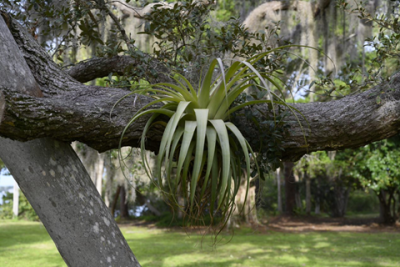
Tillandsias utriculata (Photo credit: Elizabeth Gandy)
Florida has 16 species of native bromeliads, 12 of which are in the genus Tillandsia. Eight are found in Sarasota and Manatee County. The other four species are from counties south and unlikely to be found in our area. For our November and December EcoQuests, we are reintroducing the Tilly Tally, an EcoQuest that took place May 2020. Once again we are focusing on identifying as many of our local species of Tillandsia (air plants) as possible. One of the reasons we are redoing this EcoQuest is to conduct a survey at a different time of the year compared to the 2020 survey. That allows us to see the various stages of growth and contribute information to the phenology knowledge base (that is, when do plants flower and produce fruits). Marie Selby Botanical Gardens specializes in epiphytes and botanists have been actively attempting to monitor the local Tillandsia population for decades. We produced some questions for Bruce Holst, the head of the Botany department at MSBG, regarding their research with Tillandsia in Sarasota-Manatee County.
- How long has MSBG been studying local population of Tillandsias? Why? Selby Gardens has been studying and documenting Tillandsia and other bromeliad populations since the founding of the Gardens in 1973. This plant family is important in ecology, providing habitat to many animal and microbial species, it is diverse in species composition, and it provides iconic views of our subtropical Florida.
- What do you appreciate most about our native bromeliads? And which are your favorites? As I mentioned, the iconic views of Spanish moss around the state, Bartram’s airplant in the central northern portions of the state, or the really tropical species you find in the southern swamps such as the fuzzy-wuzzy airplant (Tillandsia pruinosa) are fun to see, and they all provide important habitat or other resources for our native wildlife. I love seeing the cardinal airplants in bloom (Tillandsia fasciculata) and I especially love having wild Tillandsia utriculata in my front yard and watching it grow, seed, and proliferate over decades.
- What are the main threats to the local T. populations? How can science help? Bromeliads face two major and immediate threats, habitat destruction and for the larger-bodied species, the Mexican bromeliad weevil. You can add global climate change to the mix of threats as species will need to adapt and move north in some cases. For the swamp, or strand-loving bromeliad species, that will be difficult. Monitoring the populations and studying their phenology will provide information for land managers to best understand the dynamics of these threats, and working with botanical gardens and other agencies, we can work to maintain populations both in the field and in cultivation.
- How does citizen science contribute to conservation efforts? Adding the citizen science component to our knowledge of plant diversity and distribution provides an updated, and in some cases more detailed picture of the health of a species in nature. We have learned through our efforts with EcoFlora that this information can provide the most updated information for land managers to understand the threats of invasive species, and the most updated information on rare plant distribution. Herbarium records, while important historically, do not always provide such detailed information.
- What are some of the key signs to look for when observing Tillandsias? Look for rosettes! Those are, in the case of epiphytic bromeliads, tightly overlapping leaves in a whorled fashion that tend to be gray in appearance. There are no other plants in our area that look the same. Yet, some tillandsias break the mold, especially Spanish moss and ball moss, which are our most common tillandsias. Look especially for larger body types which tend to be rarer, which include Tillandsia utriculata, and T. fasciculata. Smaller narrow-leaf bromeliads are T. bartramii and T. simulata (both rare in our area), and T. setacea, which is common especially in areas with higher levels of humidity such as in hammocks and along riversides. Tillandsia balbisiana is found throughout the area, but rarely seen, and unusual in growth form with a bulbous base and twisted leaves.
- What observations are most valuable to scientist? Observations that include the plant habitat, flower structure, and leaves from above and below. Photographing flowers should also include views of the backside, and frontside of the flowers.
- Who reviews these observations and validates them? Observations are often reviewed by specialists in either the flora of Florida, or those that focus on a particular group of plants. Validations should only be made by those experts, unless the photographer or other user can do the work to research the differences between species and articulate them in the comments section.
Citizen Science through the iNaturalist platform provides the opportunity to contribute to biodiversity research on a local and global scale. The more knowledgeable we become as a community the more we can contribute to the preservation of a variety of species, including native Tillandsias. If you are interested in joining our Sarasota-Manatee County EcoFlora Project please click here to create your own iNaturalist account and begin observing the flora and fauna in your community. Our next BioBlitz will take place November 18th 9am- noon at Jelks Preserve along the Myakka River in southern Sarasota County. Please register with the link below if you are interested in joining us. Hope to see you out there!
November 18th BioBlitz Registration
